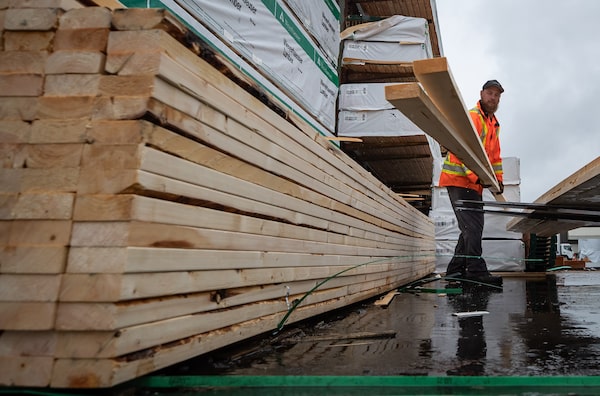
Doug Howson loads lumber at Haney Builders Supplies in Maple Ridge, B.C., on June 12, 2020. Cash prices on lumber – what sawmills charge wholesalers – jumped US$100 last week to US$745 for 1,000 board feet of two-by-fours made from Western spruce, pine and fir, or SPF.DARRYL DYCK/The Canadian Press
Lumber prices have surged after flooding in British Columbia disrupted transport routes and the United States doubled duty rates on Canadian softwood producers.
Cash prices – what sawmills charge wholesalers – jumped US$100 last week to US$745 for 1,000 board feet of two-by-fours made from Western spruce, pine and fir, or SPF.
With that 15-per-cent gain, the latest rally has resulted in cash prices soaring 75 per cent over the past 13 weeks, according to Random Lengths, an Oregon-based newsletter that monitors wood markets.
Cash prices reached a record high of US$1,630 for 1,000 board feet of Western SPF in May, before tumbling during the summer as the do-it-yourself boom ended. Consumers postponed their repair and remodelling projects after reallocating their budgets to travel, restaurants and sporting events. “The lumber bubble finally popped,” said Dustin Jalbert, senior economist at Fastmarkets, which publishes Random Lengths.
But prices dropping to US$425 in early September pulled many buyers back into the market, and this fall, the lumber market has benefited from higher-than-expected demand from consumers, Mr. Jalbert said.
Hiking U.S. duties on Canadian softwood could damage our relationship with the U.S.
West Fraser Timber says severe weather, flooding in B.C. affecting lumber and pulp shipments
Since mid-November, B.C. lumber shipments have been delayed from the reduced movement of goods after flooding and mudslides severed or slowed transport routes along rail lines and highways in and out of Vancouver, including Canada’s largest port.
In 2019, prior to the pandemic, lumber typically sold for between US$350 to US$400 for 1,000 board feet of Western SPF, though last week’s cash prices remain far below the record high in May.
Still, last week’s jump in cash prices marked the sharpest weekly rise since lumber prices hit record highs in the spring.
On the Chicago Mercantile Exchange, prices for lumber futures for January delivery have risen nearly 90 per cent since mid-August.
As Canada’s largest softwood lumber producer, British Columbia accounts for 40 per cent of the country’s output and 14 per cent of North American production.
Timber supplies from Canadian forests are located mostly on Crown land, with buyers paying “stumpage fees” to provincial governments for the right to log.
In the long-running dispute over softwood, the core of the U.S. complaint about Canadian lumber exports is the wood is sold far too cheaply, then dumped into the American market.
“Producers in British Columbia are already the marginal supplier of lumber in North America,” Mr. Jalbert said. “So between the duty increase and soaring log costs based on the province’s stumpage pricing system, lumber prices will have an unusually high floor for support in the coming months.”
The lumber market has been on a roller-coaster ride since early 2020. Demand fell during the early stages of the pandemic as consumers delayed projects around the home while housing starts also went through a lull. But then people stuck at home started a do-it-yourself bonanza in the summer of 2020, snapping up construction materials for decks and renovations.
“Volatility will be high in the first half of 2022, though we don’t expect prices to hit the levels we saw in early 2021,” Mr. Jalbert said.
Madison’s Lumber Reporter, a Vancouver-based industry newsletter, said in its weekly commentary that strong market conditions will likely stretch into the new year, given “severe transportation disruptions, positive lumber futures and the trade dispute between Canada and the U.S.”
On Nov. 24, the U.S. Department of Commerce announced a new duty rate of 17.9 per cent against most Canadian lumber producers, compared with the previous tariff of 8.99 per cent. The new duty rate took effect on Dec. 2.
Susan Yurkovich, president of the BC Lumber Trade Council, said higher duty rates create a ripple effect. “That’s why you’re seeing price pressures, and ultimately those are borne by U.S. consumers who are trying to build homes or repair and remodel,” she said.
Ms. Yurkovich urged U.S. President Joe Biden to make the softwood file a priority. “We’ll be looking for areas where we can share common interests and where we can get them to have a discussion about lumber because it’s a really important issue to resolve for Canada,” she said.
Raymond James Ltd. analyst Daryl Swetlishoff said the new rates for countervailing duties and anti-dumping levies could eventually decline, perhaps in the summer of 2022. He said he doesn’t expect any imminent resolution to the softwood dispute, but he says that in the previous round of the trade battle, Canadian producers won back about 80 per cent of tariffs that they had paid to the United States.
Last week, International Trade Minister Mary Ng led a Canadian delegation on a three-day visit to Washington to raise concerns about looming tax credits for U.S.-made electric vehicles that could devastate auto assembly in Canada, and she also drew attention to the doubling of softwood duties.
“Over three days, the Team Canada delegation emphasized the importance of the Canada-U.S. secure and resilient supply chain and the key role it will play in the postpandemic economic recovery,” Global Affairs Canada said in a statement issued on behalf of Ms. Ng on Friday night as the trade mission wrapped up.
Your time is valuable. Have the Top Business Headlines newsletter conveniently delivered to your inbox in the morning or evening. Sign up today.